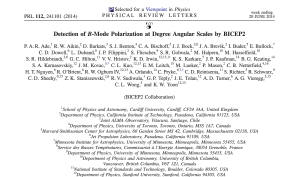Blog
Papers Please
21 June 2014
 Physical Review Letters
Physical Review LettersThe BICEP2 paper has officially been accepted in Physical Review Letters.1 Having survived peer review, does that mean we can now declare that inflation has now been officially observed? Not necessarily.
You might remember the ongoing saga of the BICEP2 results, from the first press release announcing the detection of B-mode polarization within the cosmic microwave background. There are several sources of this kind of polarization, but one of them is inflation in the early universe. The announcement made headlines everywhere, but also stirred a great deal of controversy. It didn’t take long for “peer review” to start pushing back on the results. First was evidence that interstellar dust could create B-mode polarization in addition to other sources. Then results from the Planck satellite were released with some dust polarization results. Then came news that the BICEP2 team had used some “reverse engineered” data from a Planck result, that some argued invalidated the results.
As I’ve pointed out in earlier posts, these kinds of hard hitting attacks are part of what peer review is all about. The fact that it occurs publicly has more do to with the publicity of science rather than some failure in the process. But behind all the public drama over the results, there has been the real academic process of peer review. The BICEP2 team submitted their paper to Physical Review, and the paper has been accepted with some changes. It has officially survived the process that I often tout as the gold standard of science.
Does that mean the BICEP2 team has won? In a way, they have. Surviving peer review is no small feat, particularly for a controversial result such as early inflation. But the revision of their paper is also significant. In particular, the paper admits that their result might not be a real signal of inflation after all. From the abstract, they state:
However, these models are not sufficiently constrained by external public data to exclude the possibility of dust emission bright enough to explain the entire excess signal.
So they have a real observation of B-mode polarization, and it looks like evidence of cosmic inflation, but they can’t rule out the possibility that their signal is just due to interstellar dust. They also state that more data will be needed to answer that question.
This is what peer review gives us. The BICEP2 team made bold initial claims, and they were taken to task. Much of their initial claims have survived the process, but their bold claim has given way to a more cautious result. They got a paper out of the work, but they also had to eat a bit of crow, and that’s never easy.
But what we get in return is a better understanding of the universe.
Ade, Peter AR, et al. “Detection of B-mode polarization at degree angular scales by BICEP2.” Physical Review Letters 112.24 (2014): 241101. ↩︎